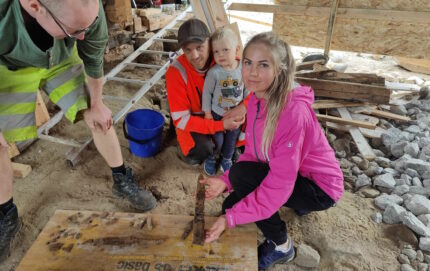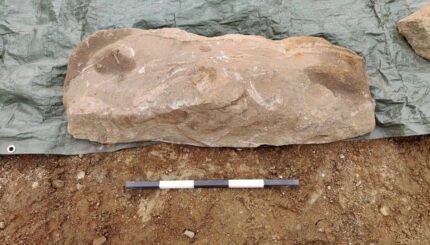 Homeowners in Setesdal, southern Norway, have discovered a Viking warrior burial in their backyard. Oddbjørn Holum Heiland was digging a little to get the jump on an addition he and his wife Anne are planning on building when he encountered an oblong stone just under the grass and top soil layers. He kept going, and in his next pail full of top soil, he spotted an iron object that looked a lot like a sword. Because it was a sword blade. When he dumped out the soil from the digging bucket, a sword hilt fell out. A little Googling revealed that the shape of the sword suggests it was of Viking origin.
Homeowners in Setesdal, southern Norway, have discovered a Viking warrior burial in their backyard. Oddbjørn Holum Heiland was digging a little to get the jump on an addition he and his wife Anne are planning on building when he encountered an oblong stone just under the grass and top soil layers. He kept going, and in his next pail full of top soil, he spotted an iron object that looked a lot like a sword. Because it was a sword blade. When he dumped out the soil from the digging bucket, a sword hilt fell out. A little Googling revealed that the shape of the sword suggests it was of Viking origin.
Heiland stopped digging and alerted the county to his potential find. The next day, county archaeologist Joakim Wintervoll and Jo-Simon Frøshaug Stokke from the Museum of Cultural History in Oslo, came to view the sword in person. They confirmed it was Viking, and that Heiland had likely excavated a tomb in his own backyard.
The two pieces of the sword that were found make out a 70 cm long sword, and the blade is 5 cm at the broadest point.
“But it’s the hilt that tells us this is a sword from the Viking Age,” Wintervoll explains.
The hilt of a sword is an object of fashion, and the style of the hilt found in Setesdal places it at around the end of the 800s and the beginning of 900.
“We have datings for different styles of hilts from year zero, so we have a pretty good overview of how these hilts have changed from the early Iron Age and into the Middle Ages,” Wintervoll says.
The house dates to 1740 so the grave was lurking under a few inches of sod for a thousand years and by  a complete fluke, construction of the house just missed it. The grave also contains a lance, gilded glass beads, a brooch and a belt buckle which was probably also originally gilded. This is an intact, integral assemblage of luxurious grave goods. The person buried must have been someone of high status. There is no evidence that there was ever a mound marking the grave, but the large oblong stone that covered the grave may have been standing originally, only to topple over later. In that case it would have been highly visible in the landscape. If it was deliberately laid horizontally as a headstone, its location would have been significant to the people who lived there at the time.
a complete fluke, construction of the house just missed it. The grave also contains a lance, gilded glass beads, a brooch and a belt buckle which was probably also originally gilded. This is an intact, integral assemblage of luxurious grave goods. The person buried must have been someone of high status. There is no evidence that there was ever a mound marking the grave, but the large oblong stone that covered the grave may have been standing originally, only to topple over later. In that case it would have been highly visible in the landscape. If it was deliberately laid horizontally as a headstone, its location would have been significant to the people who lived there at the time.
There used to be a collection of smaller farms just 100-150 metres away from where the grave is located. It is reasonable to assume that these farms existed back at that time, or perhaps even further back in time, according to the archaeologist.
“A pattern that we see is that you bury those who have owned land near the farm, and often in a spot that is easily visible from the nearby roads. People who passed by would then see the grave and know that the people who live here have ancestors who have lived here for a long time. These are our relatives; we lay claim to this land and have done so for generations. This is the function of the visible grave,” Stokke says.
No human remains have been discovered yet, and archaeologists are not optimistic they’ll find any when excavations resume next week, especially since cremation was common at this time, leaving only fragments of charred bone to be found today, if anything.